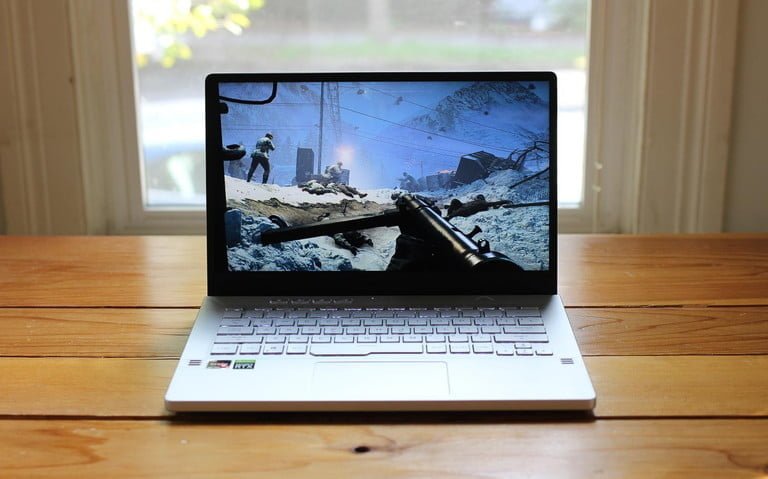Tracking down the best laptop for college is no easy task. You want something that can handle papers and note-taking week after week, a battery that can last you all day without a charge, and a price that won’t empty your wallet before you’ve had a chance to buy any books.
Gaming laptops don’t really fit that mold. Unless you’re willing to spend up for a premium gaming machine, you’ll often sacrifice what makes the best laptops the best in favor of a beefy graphics card and processor.
In 2021, you can still game while having a good laptop for school. Here’s why you shouldn’t pick up a gaming laptop and what you should buy instead.
Keyboards are often an afterthought

Gaming laptop keyboards have improved over the past few years, but they’re still not very good. Take the Asus ROG Zephyrus G14, for example, which has one of the better gaming keyboards on the market and still manages to feel mushy. The inexpensive Dell G5 SE has a decent keyboard, but it still carries the asterisk: For a gaming laptop.
After struggling through notes in class or making one too many typos in a paper, you’ll probably wish you had a better laptop keyboard. Many non-gaming machines don’t make you compromise. The Lenovo ThinkPad X1 Nano, for example, is around the same price as the Zephyrus G14 and has the same satisfying typing experience as the rest of the ThinkPad range.
There are exceptions like the Razer Blade 15, but unless you can get hands-on with a unit, you’re rolling the dice when it comes to a gaming laptop keyboard.
Gaming laptops require a lot of power, and they’re hot

Even if you’re not running a game, gaming laptops can suck up a lot of power. They’re designed with gaming in mind first, with high-powered processors and graphics cards at their core. Although most recent processors can reduce their power draw outside of games, they often suck up more juice than their low-powered counterparts.
The Acer Predator Triton 300 SE has better battery life than most gaming laptops thanks to its lower-wattage CPU, but it’s still not great. In our web-browsing test, the laptop lasted seven-and-a-half hours, which is on the high end for gaming laptops. Cheaper gaming laptops even end up lasting a few hours less. Compare that with the HP Elite Dragonfly, which lasted over 10 hours in the same test.
Of course, the byproduct of power is heat, and gaming laptops don’t always handle it well. Even the Razer Blade 15 can get toasty while idle, and the MSI GS66 Stealth can reach temperatures of 97 degrees Celsius when pushed. Outside of uncomfortable wrists, noisy fans can get in the way of a video call or just annoy your classmates in-person.
Gaming laptops are expensive

You can find a gaming laptop for under $1,000, but you’ll need to trade build quality, components, and display quality to meet that price. To get a laptop that’s great for gaming and school, you’ll need to pay up. The Razer Blade 14 is a laptop that can do gaming and work well, but even the cheapest model will run you about $2,200.
Non-gaming laptops can get expensive, too, but you have a lot more high-quality options around the $1,000 mark. The Asus ZenBook 13, for example, clocks in at around $800 and comes with an excellent keyboard, a beautiful OLED display, and a battery life of nearly 16 hours. You won’t find any of that on a gaming laptop for the same price.
The mid- to high-end for laptop prices is where most gaming machines start — assuming you want something remotely capable of running the latest games. Again, there are exceptions like the Dell G5 SE that manage impressive gaming performance for under $1,000, but it still doesn’t stack up to non-gaming laptops at a similar price.
What you should buy instead

You don’t need a gaming laptop to get the best of both worlds. Cloud gaming is constantly improving, offering you access to the latest AAA video games without the computing overhead, and many mobile chips come with decent integrated graphics, allowing you to run basic games at lower resolutions and settings.
The MacBook Air M1 is a prime example, which is among the best laptops for college. It’s cooled entirely through the body, so you don’t have to deal with a noisy fan, and it has one of the best laptop keyboards on the market.
It can run some games, too. In our testing of the M1 MacBook Air, we reached 33 frames per second (fps) in Fortnite and 51 fps in Civilization VI. It’s not show-stopping gaming performance, but the M1 MacBook Air still handles gaming better than many of its Intel counterparts.
If you’re more into Windows, there are plenty of options. Our go-to recommendation is the Dell XPS 13 thanks to its snappy and precise keyboard, excellent CPU power, and beautiful, ultra-thin bezels. The Tiger Lake chip powering recent models includes decent integrated graphics, though you’ll probably need to bump down the resolution.
For more demanding titles, you can turn to cloud gaming. It isn’t ideal, but services like Xbox Game Pass and GeForce Now make a solid argument for the technology, and they don’t lock you into a specific platform the way Google Stadia does.
Popular live service games like Destiny 2 and Apex Legends are available across multiple platforms, and single-player blockbusters like Cyberpunk 2077 are available, too. In the case of GeForce Now, you can actually build your Steam library since it uses games that you already own.
There are a few situations where a gaming laptop might be a better choice, though. If you have access to creative apps like Blender and Adobe Premiere Pro, a gaming laptop can help speed up those apps. Still, it’s best to pick up a solid non-gaming laptop and use cloud gaming in most cases.
Editors’ Recommendations
